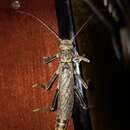Conservation Status
provided by University of Alberta Museums
The species is not endangered, but as with all stoneflies, it is sensitive to organic pollution.
- license
- cc-by-nc
- copyright
- University of Alberta Museums
Cyclicity
provided by University of Alberta Museums
Adults emerge in late June to mid-July.
- license
- cc-by-nc
- copyright
- University of Alberta Museums
Distribution
provided by University of Alberta Museums
In Alberta, this species is known from the Saskatchewan River system, and from boreal and mountain streams. In North America, it ranges from the Cordilleran region of British Columbia and Alberta through the Cascade and Rocky Mountains to New Mexico and east to northern Manitoba and northern Ontario.
- license
- cc-by-nc
- copyright
- University of Alberta Museums
General Description
provided by University of Alberta Museums
Males (length = 19.6 mm) are brachypterous, but females (length = 31.4 mm) are long-winged. Males have genital hooks darkly sclerotized at their tips and arising from lateral angles of Tergum 10. Males also have a raised knob or "hammer" on Sternum 9. The female subgenital plate is broadly rounded, usually with a shallow median recession and is little produced over Sternum 9. The subgenital plate has a row of spinules along its posterior margin. Nymphs have anal gills and an occipital ridge composed of spinules.
- license
- cc-by-nc
- copyright
- University of Alberta Museums
Habitat
provided by University of Alberta Museums
Larger, coolwater streams and rivers.
- license
- cc-by-nc
- copyright
- University of Alberta Museums
Life Cycle
provided by University of Alberta Museums
The life cycle is three years in Saskatchewan, and the nymphal habitat is under stones in swift riffle areas. Adults are nocturnal, emerging at nightfall and when active at dusk or night have the ability to move on the surface of the water somewhat like water-striders. Mating can occur as soon as the female emerges from its nymphal exuvium.
- license
- cc-by-nc
- copyright
- University of Alberta Museums
Trophic Strategy
provided by University of Alberta Museums
Nymphs are carnivorous, feeding on mayfly nymphs, black fly and chironomid larvae.
- license
- cc-by-nc
- copyright
- University of Alberta Museums
Claassenia sabulosa
provided by wikipedia EN
Claassenia sabulosa, the short-wing stone, is a species of common stonefly in the family Perlidae. It is found in North America.[1][2][3][4]
References

- license
- cc-by-sa-3.0
- copyright
- Wikipedia authors and editors
Claassenia sabulosa: Brief Summary
provided by wikipedia EN
Claassenia sabulosa, the short-wing stone, is a species of common stonefly in the family Perlidae. It is found in North America.
- license
- cc-by-sa-3.0
- copyright
- Wikipedia authors and editors

